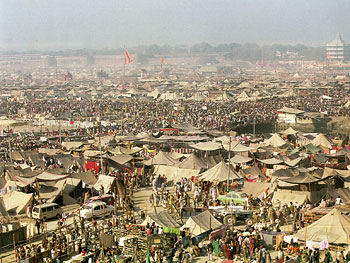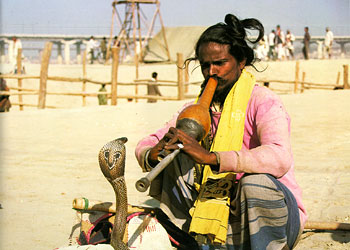
An entire city was erected along the bank of the Ganges during the kumbha mela, complete with roads, street lights, telephone booths, markets, a maternity ward, and even a tourist camp to accommodate foreign visitors. The tourist camp officials claimed to have sheltered over 1,000 European and South American visitors during the 1989 festivities. Some of these tourists had never been to India before and were assimilating the experience as best they could, while others seemed as well acquainted with what was happening at the kumbha mela as did the Indians.
The market areas offered all the necessities and luxuries of kumbha mela life. Vendors sold fresh fruits and vegetables. Wool blankets, a brisk-selling item, were piled in big stacks for easy selection. Along the main thoroughfares, Gypsies spread their wares, which included different shapes and sizes of brass pots and bowls, beads for meditation, exotic perfumes, fragrant incense like kasto (musk) and chandan (sandalwood), and even tigers' claws set in gold.

For the novelty-seekers at kumbha mela, there was a wide selection of oddities available in the market. For a rupee, one could employ a snake charmer who, by playing on his pungi (flute), would make the cobras dance, swaying to and fro. It is a longstanding belief that the cobra is charmed by the sound of the pungi; however, having observed several of these performances, it was our conclusion that the snake charmer charms his audience rather than the snake.
Many palm readers and mystic astrologers set up shop along the bank of the Ganges, offering passersby a look into the future. Astrology and palmistry are traditional sciences in India, but one could not help but think that some of these "mystics" were out to turn a fast rupee from a gullible public. Undoubtedly, among the sincere and authentic spiritualists at Kumbha Mela there were also the cheaters and hence the cheated.
All food served at the Mela was vegetarian. No meat, fish, or eggs were to be found in any camp or public eating place, as meat-eating is strictly prohibited among all ascetics and holy men in India.
Overlooking the site on the high bank of the Ganges stands the Akbar Fort. Entering the fort through a gate on the eastern side, one could climb the walls for a panoramic view. In the midst of the fort there is a banyan tree known as Akshay-bhat, "the tree that never dies." This tree was planted by Shankara and is a site worth seeing, as it is over one thousand years old, yet shows no signs of aging.
